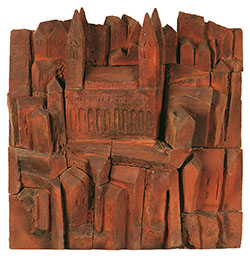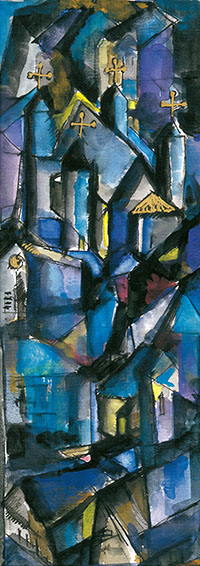Attracted by a city – cityscapes, vedutes
In the history of art the objective description of landscape, town or a set of bulidings is called a vedute. The development of this field similarly to that of the portrait began in the renaissance. The frst vedutes served as a background of altarpieces, votives. Throughout the centuries it has undergone significant changes and by today the original picture function – the more precised details of the objective reality has been replaced much more with the emotional, intellectual content, which describes the artist’s attitude to the place formed.
This classical genre has a unique place in the ceramist’s, Árpád Csekovszky’s works. It is typical of his life’s work to go around a theme consistently and reshape it in numerous variations. The original role of the vedutes, that is to serve as a background, appears in the relief sculptures made from the 1970s recalling the features of the place with exquisite simplicity and they give the prominent background of the later works such as St George or the one depicting the Turks Capturing Pécs in the niche-sculptures.
Except a few ones, the representation of these cityscapes originates from Pécs. The steeples of the Cathedral and the houses surrounding Church Square moulded in relief form the composition in a recognisable and identifiable way. The steeples of the church and the tiny roofs closeby give a unique atmosphere.
Even if plastic is not completely a concrete representation, the experience based on the square of Pécs, the church tower’s emerging coloumn, the playful, airy spires and the buildings around forming the square are the recurring subjects of these compositions. Mostly this motive is shown in a round, tondo shape, formed playfully with strict, geometrical shapes recalling the well-balanced scale of the surroundings and the past built over the centuries.
The high-quality of these rather small statuettes and their compositional structure bear the particular style and technique with which Árpád Csekovszky built up and shaped all his works.

His compositions are charactirised by the domination of the sharply emerging shapes from the surface and the playfulness infiltrating the firmly closed cubes of buildings. Although we can find colourful, glazed ones among the niche-reliefs, most of them are moderately coloured with oxides, which make the light-shade effect quite powerful from the plastic moulding.
Most of these cityscape reliefs were put on the art market through the Arts and Crafts Company.
The summary of the cityscape topic appeared on the 60 square meter wall composition called In Memory of the old town centre (1976) put up in Veszprém, in 1975. The large sized composition gave the possibility to summarize the previous experience, to unfold the firmly closed shapes into a playful composition based on the light-shade effects and to show the capriciously bending buildings lined up in the mediavel streets, where a laced gable and tower of a detailed facade or an open gate turns up just like in a fairy tale.
However, the cityscape depiction of the niche-reliefs made in the 90s has a new function - it serves as a background to the fight of St George and the Dragon or the Capturing Pécs (1994). The plasticly shaped buildings spectacularly form the Turkish soldiers outside the gates and the fighting crowd’s movement in the background.

The four-towered Cathedral of Pécs, the most often used element of the cityscaspes turns up as a prevailing space-arranging motive not only in the centre of the composition, but often fully emerging from the flat surface modelled plastically.
In many cases the plasticity of these small-sized works is much more powerful, intensive than that of the murales, as the smaller surface is more suitable for the offbeat experimentation without throwing the composition out of balance by a more emphasised element. The best example of this is the model-like spacial moulding of Pécs Cathedral and composing it as a relief.
Each of the numerous citiscape reliefs is a bustling composition made up of cubes. The powerfully emerging and spacial plastic art emphasises the rhythm of the buildings surrounding the cathedral, the lines and the crowdness of the streets with definite and dynamic light-shade effects.
The citiyscape reliefs occupy a particular place in Árpád Csekovszky’s works of art. The vedute, the old artistic form, which is traditionally represented within the graphic arts and painting, gains new dimensions in his works – it expressess the artistic subject and intuition, in the material of the ceramic it gives the opportunity of free modelling; personal moods, and the experience for life of a specific, human scale square. This topic is the Cathedral Square of Pécs and the view of the buildings surrounding it as well as the wide-ranging solution to the formal – plastic problem which occupied the artist continually – that is the rhythm of the cubes placed beside one another, their spatial connection, the relation of crowds and shapes about which he showed great concern in most of his works.
Although it is less known, his painting ouvre is quite significant both in numbers and quality.
The main subject of his paintings is the cityscape, too. It goes without saying, that the same elements about which the Master was concerned in his ceramics, appear natural on a flat surface.
The sensitive, unique colours of his paintings spread from that of the almost monochrome ceramics coloured with oxides to the powerfully expressive polichrome. Shown on flat surface, from the strictly bordered geometrical surfaces that sharply cut each other, the shiny white and yellow besides the dark tonality of blue and green relieve the strictness of the perspectives made up of mostly stressed diagonals making even the static descriptions quite bustling.

The cityscape as a subject in Árpád Csekovszky’s oeuvre is just a segment, but as a visual and spiritual experiment from a determinant experience of his youth meant an attachment for life. This experience was shared with the public through his works reinterpreted in numerous shapes composed in the language of sight.
